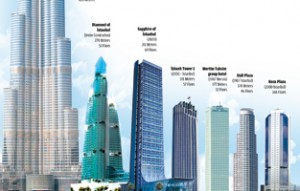Source: www.todayszaman.com
As skyscrapers like the Burj Khalifa are built throughout the world to topple records and flex national and economic muscle, in the megacity of İstanbul such tall wonders are seen as necessities as its population and its finance sector grow to new heights.

The 181-meter-high İş Bankası building in İstanbul’s Levent district held the title of the tallest building in the 13-million-strong city until last year, when Sapphire of İstanbul, a 261-meter mammoth, also in Levent, clinched the title. In 2010, the $180 million 270-meter-high Diamond of İstanbul will be completed, narrowly taking the title of the tallest building in Turkey. All of these triumphant buildings, however, are tiny in comparison to the 828-meter Burj Khalifa in Dubai.
As İstanbul continues to be the economic powerhouse of Turkey, populations looking for work are migrating to the city, making it difficult and expensive for developers to build horizontally and thus redirecting their view to the skies. Real Estate Investing Partners Association (GYODER) President Turgay Tanes, speaking to Today’s Zaman, stated that “an increasing population, a lack of land in cities and the high price of available land means that there is a vertical trend in building development.”
Tanes noted, however, that along with this trend in the vertical, there is also a trend toward sustainable and environmentally friendly buildings. Calling on architects, engineers and investors not to ignore the sustainability of such tall initiatives, he said Turkey is currently obtaining more knowledge about this vital issue. “Currently there are buildings that are green certified. Investors in the sector have mostly internalized the concept of sustainability for buildings,” said Tanes. He added that building vertically can have benefits in the field of environmental impact and sustainability, as demand for private transportation and the increasingly widespread nature of public transportation is making it a necessity to have more centralized buildings and workplaces.
According to research by the organizations behind the Leadership in Energy and Environmental Design (LEED) Green Building Rating System and the Building Research Establishment Environmental Assessment Method (BREEAM), environmentally friendly buildings can decrease the operating costs of a building by 8 to 10 percent, while also shrinking energy costs by 40 percent.














